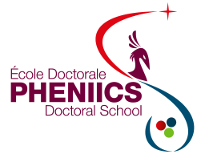Orateur
M.
Federico Scozzi
(IPN Orsay)
Description
The High-Acceptance Di-Electron Spectrometer (HADES) operates at the GSI Helmholtzzentrum für Schwerionenforschung in Darmstadt with pion, proton and heavy-ion beams provided by the synchrotron SIS18. HADES results on e$^+$e$^-$ production in proton-nucleus reactions and in nucleus-nucleus collisions demonstrate a strong enhancement of the dilepton yield relative to a reference spectrum obtained from elementary nucleon-nucleon reactions. These observations point to a strong modification of the in-medium rho spectral function driven by the coupling of the $\rho$ to baryon-resonance hole states. However, to scrutinize this conjecture, a precise study of the electromagnetic baryon-resonance transition form factors in the time-like region is mandatory.
A promising approach are reactions of the type $π^{-}$N → R → e$^+$ e$^-$ N, for which no experimental data exist yet. In summer 2014, HADES took data using pion beam on carbon and polyethylene targets. A large part of the data was taken at a pion beam momentum of 0.69 GeV/c in order to explore the second resonance region and the sub-threshold coupling of the ρ to baryonic resonances. In this talk the preliminary results of inclusive dilepton production and for the exclusive channel $π^-$p → e$^+$ e$^-$ n will be presented and compared with different model calculations. The necessity of introducing VMD will be pointed out as well as the possibility to get some hints about the resonance contributions using angular distributions of dileptons.
Auteur principal
M.
Federico Scozzi
(IPN Orsay)



